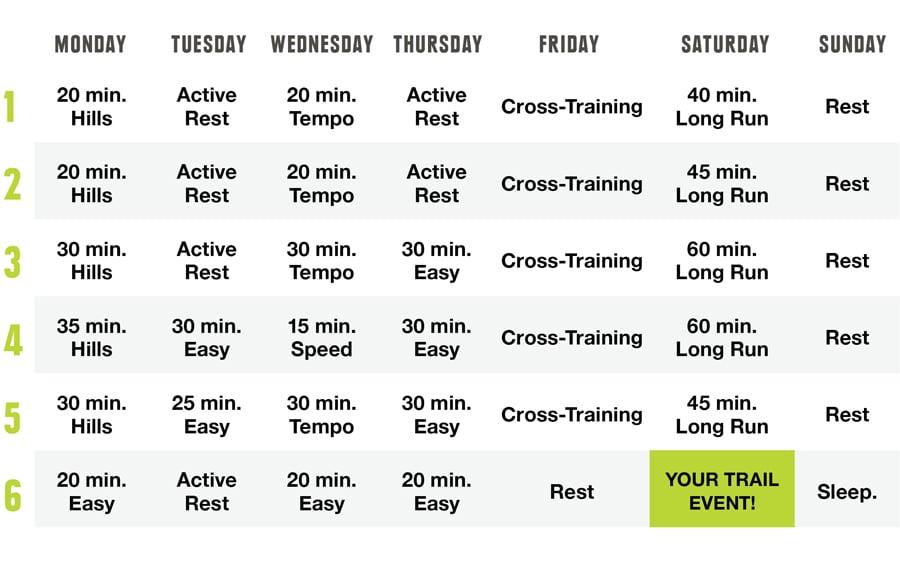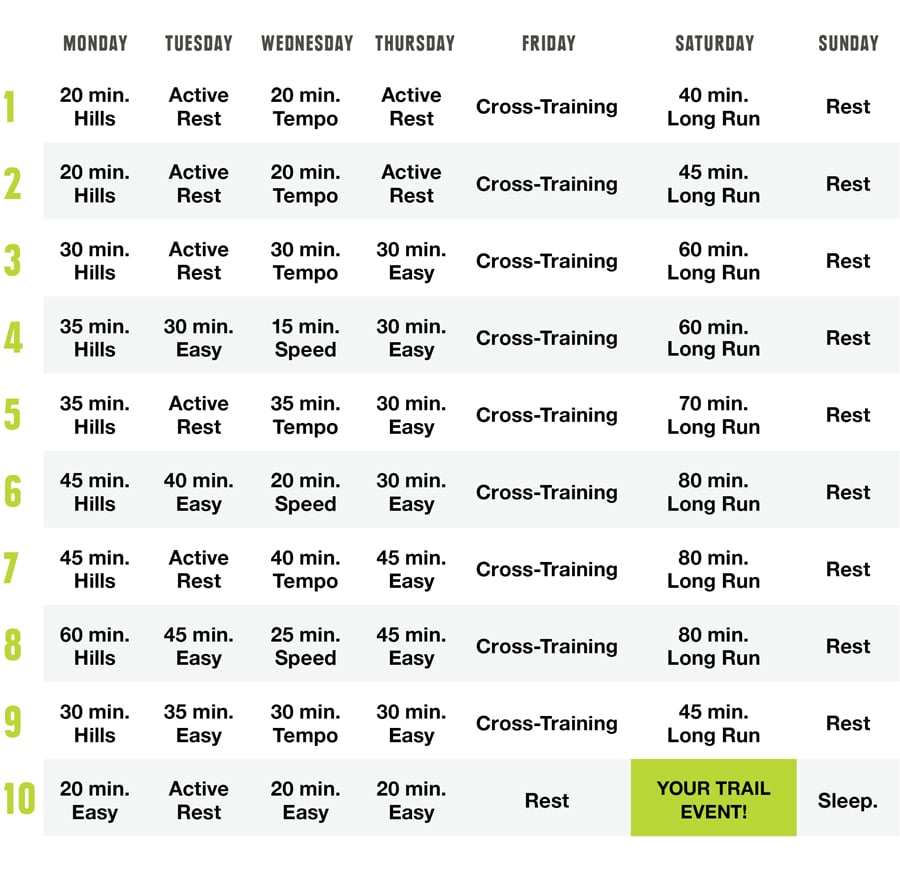For many, trail running offers a spiritual, albeit aerobic, connection with Mother Nature. An equally human desire, though, is to test your limits—to see how much faster and farther you can go. Whether your goal is a race result or a target distance, you need a training plan.
Below is a training primer for a 5K or 10K event. You can find a wide range of plans and approaches out there, but all plans typically have a mix of the following:
- An initial physical assessment
- A variety of running tempos and terrains
- Dynamic warmup, along with post-workout cooldown and stretching
- Cross-training to build strength and endurance
Your Initial Physical Assessment

This article assumes you have a rough idea of your level of physical conditioning and that you have already decided whether or not you want to do a 5K or a 10K trail run.
Your first step, as it is with any new training program, is to consult your physician. After that, you can train solo, but taking some classes, joining a running club and/or finding a coach or trainer is always a wise move.
Find a Running Class or Club at REIYou can also get technique help from trail-running classes and clubs:Find your class
Monitoring Your Heart Rate: You can train more efficiently if you wear a heart rate monitor. Each type of running you'll do is intended to be done at a particular heart rate. That number varies with your age and fitness, among other variables. To learn more, including how to calculate maximum heart rate (HRmax), read How to Train Using Heart Rate Zones.
If you're not interested in getting that scientific with your training just yet, we also offer an alternative way to guesstimate heart rates for each training pace, the talk test:
- Easy Run: 60-65% of HRmax OR you can carry on a conversation as you run (or a soliloquy if you're training solo).
- Long Run: 70-80% of HRmax OR you can speak sentences, but not tell long-winded stories.
- Tempo Run: 85-88% of HRmax OR you're only able to utter single words.
- Speed Run: 90+% of HRmax OR you're only able to gasp or grunt, not speak.
5K and 10K Training Schedules
For a comprehensive approach to your training, you can simply follow one of these calendars:
6-Week Program for a 5K Trail Run

10-Week Program for a 10K Trail Run

5K Printer-friendly version (PDF)
10K Printer-friendly version (PDF)
You can also use our training calendar as a starting point, then modify it based on your experience and needs. Regardless of the calendar you choose, your weeks should start easy, gradually become harder and then become easier the week prior to your event.
Pre- and Post-Run Routines
Each type of run (except easy runs), along with hill work, should be bookended by the following routines. See the related article list at the bottom of this page for specific exercise suggestions and details about how those exercises should be done.
- Dynamic warmup: activities like skipping, lateral shuffles, high knee exercises and butt kicks can all be effective at warming up muscles through a range of movement. Spend at least 5 minutes before each run doing these.
- Cooldown: Spend at least 5 minutes after your running session jogging slowly, then walking.
- Stretching: Spend 5 to 10 minutes after your cooldown doing static stretches. Concentrate on your least flexible muscles. Yoga poses and foam rolling during this time can also improve flexibility and recovery.
Types of Run Paces
Your body is efficient at adapting to doing the same thing repeatedly—like running a particular distance on a particular course. In order to improve, you need a variety of paces. Each pace engages a different energy system, which in turn provides benefits ranging from improved efficiency and running mechanics to better cardiovascular conditioning.
Varying training paces also mimics trail-running conditions, because terrain and elevation changes require you to constantly adapt your running pace. Our 5K and 10K plans include the following running paces:
![]()
Easy run: The goal is to stay active as you build your cardiovascular base miles. Easy runs are the foundation of any good training program. Slip in a run between your other responsibilities. Make it social to help you stay motivated.
![]()
Tempo run: Run at your tempo pace for a prescribed amount of time, followed by a jog, then repeat the sequence until you reach the total tempo-pace time for that day on your training calendar. Tempo runs improve metabolic efficiency, making it easier to run at this pace before your muscles fatigue.
![]()
Speed run: Run at your speed pace for a prescribed amount of time, followed by a jog, then repeat the sequence until you reach the total speed-pace time for that day on your training calendar. Speed runs improve cardiovascular conditioning and heart and lung strength. Your body learns to run at a fast pace more easily, making you a more efficient runner.
![]()
Long run: These runs stretch the limits of your base miles and develop your aerobic endurance. Get out and explore new trails and focus on honing your running mechanics rather than racing.
![]()
Hills: Climbing and descending are both critical skills for trail running. Repetition helps you improve your technique and hone your cadence for your fitness level. This training also helps build muscle and increase endurance.
![]()
Cross-training: The purpose is to increase the fitness and strength of muscles that support the primary running muscles. Plus, you get a break from running's repetitive motion. Include a core workout, plus resistance and strength training.
![]()
Active rest: Do any activity that keeps your body and muscles moving without taxing your cardiovascular fitness or recovery process. That includes activities like light walking, passive yoga poses or a stretching/foam-rolling session. Active rest days help prevent soreness and reduce the likelihood of injury.
![]()
Rest: The goal on these days is to give your body a break. Rest days are critical to avoid overuse injuries.
Training Tips

Don't run too fast on "easy" runs: Don't expect the miles to melt away, because an easy pace will often feel far too slow for a new runner. You might also struggle with it because you're not moving fast enough to feel like you're in "the zone." If you keep chugging along at a pace where chit-chat comes easy, then you're doing fine.
Train by time, not distance: This is especially true for new runners because fixating on a distance can make it hard to maintain your correct training pace. It can also dishearten you if you're simply not ready to run a longer distance yet.
And there's the practical argument, too: Most of us have busy schedules and need certainty about the amount of training time we're setting aside.
Try to catch injuries early on: Trying to push through injury is a common mistake. The result is inevitably more damage and having to abandon training altogether until you're completely healed.
The difference between soreness and injury is usually signaled by pain that's concentrated in a single place or on just one side of your body. If the calves of both legs are uniformly sore, that's probably a sign that the training has gotten serious, not that you're seriously injured.
Be on the lookout for the first sign of an injury. Catch it early and you might be able to take a day or two off and heal adequately. When you resume, start with an easy day.

